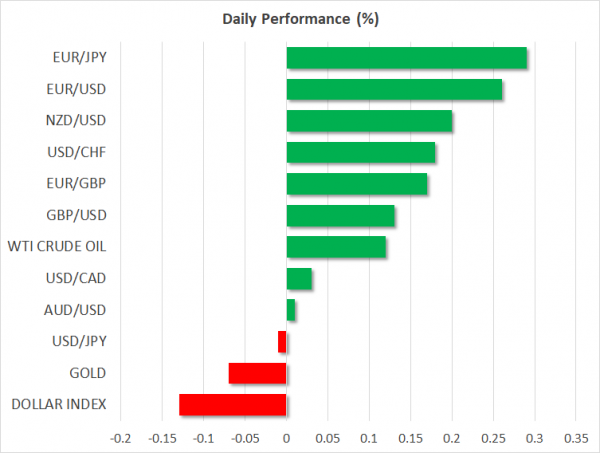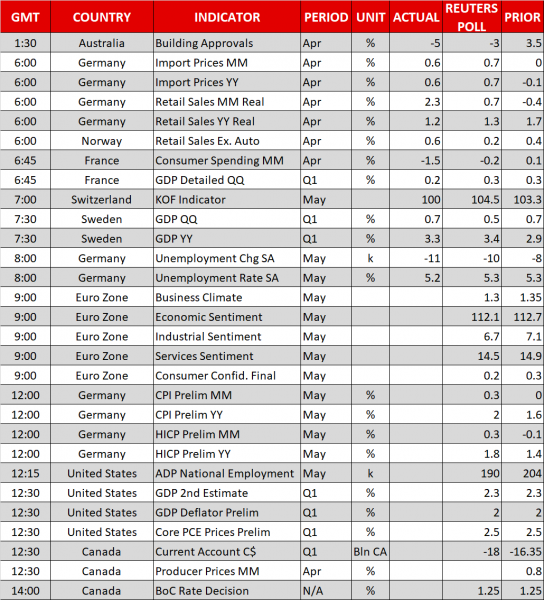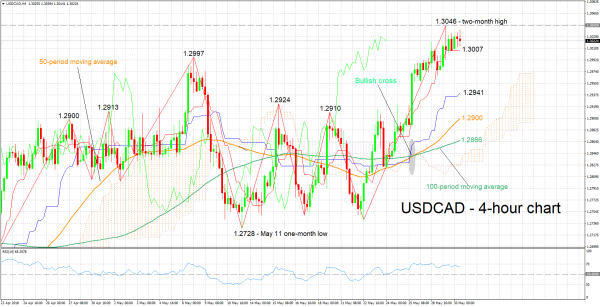Here are the latest developments in global markets:
FOREX: The US dollar index is down by roughly 0.1% on Wednesday, giving back some of the gains it posted yesterday, when it touched its highest point since early November. Meanwhile, although the euro posted considerable losses yesterday, it has rebounded somewhat today, trading higher by 0.3% versus the yen and 0.25% against the dollar.
STOCKS: Wall Street was slammed yesterday, with all major US indices posting hefty declines as Italy’s political predicament sent shockwaves across financial markets, while US-China trade tensions added another reason for investors not to take much risk. The Dow Jones plunged 1.58%, while the S&P 500 and the Nasdaq Composite declined by 1.16% and 0.50% respectively. That said, sentiment seems to have rebounded a little today, as futures tracking the Dow, S&P, and Nasdaq 100 are all pointing to a higher open. Meanwhile, Asian markets were a sea of red. Japan’s Nikkei 225 and Topix fell by 1.52% and 1.46% correspondingly, while in Hong Kong, the Hang Seng tumbled 1.55%. In Europe, futures following most of the major benchmarks were in positive territory, with the two exceptions being the UK’s FTSE 100 and France’s CAC 40.
COMMODITIES: Oil prices were marginally higher on Wednesday. WTI rose by a little more than 0.1%, while Brent climbed by roughly 0.05%, both benchmarks stabilizing a little after posting considerable losses in recent days. Prices have been weighed on by speculation that Saudi Arabia and Russia will “open the taps’ soon and raise their output materially, in order to offset any supply losses from Iran and Venezuela. In precious metals, gold is down today but by less than 0.1%, currently trading not far above the $1,296/ounce mark. The yellow metal exhibited a “dead cat bounce’ yesterday, briefly spiking higher to re-challenge its 200-day moving average at $1,307, only to find fresh sell orders and edge back down.
Major movers: Euro catches its breath after plunge; trade frictions back in focus
Italian politics remained in the spotlight on Tuesday, with the euro extending its losses and touching fresh multi-month lows against the dollar, the yen, as well as the Swiss franc. Markets continued to price in the possibility of this crisis deepening further, as the early elections that will probably take place this summer are increasingly being framed as an implicit referendum on the euro.
Nonetheless, the leader of the Five Star Movement Luigi Di Maio said yesterday he never sought a euro exit. His remarks helped to stop the bleeding in the currency, and it even managed to rebound slightly in the aftermath, as he probably calmed the nerves of investors worried over an “Italexit’ from the euro. As for bond markets, the big story has been a rotation away of periphery EU countries. Money is flowing out of Greece, Spain, Portugal, and of course Italy, and finding its way into Germany, France, the UK, and the US – evident by the former group’s government bond yields rising and the latter’s declining.
Interestingly, markets are betting that politics will affect monetary policy as well. Investors have pushed back the expected timing of the first 10bps rate increase by the ECB to the fourth quarter of 2019; it was anticipated to come during the second quarter just a few months ago. Across the Atlantic, the implied probability of the Fed raising rates at the June meeting has fallen to 74%, from nearly 100% last month. While this repricing makes sense with respect to the ECB, it appears questionable with regards to the Fed. The US economy is humming along nicely and for policymakers to shy away from pressing the hike button in June, the global outlook may need to deteriorate by much more than what we have seen so far.
On the trade front, the White House warned it will move ahead with plans to impose up 25% tariffs on $50 billion worth of Chinese imports if Beijing does not swiftly address the issue of intellectual property theft. This appears to be one more way for the US administration to raise pressure on China amid ongoing negotiations, though markets largely overlooked it as the Italian narrative dominated headlines.
Day ahead: Bank of Canada decides; German inflation, US ADP report and revised GDP figures also due
Wednesday’s calendar features numerous releases of relative importance, as well as a Bank of Canada decision on interest rates.
The eurozone will be on the receiving end of numerous surveys gauging business and consumer confidence during May at 0900 GMT. All surveys are projected to show a deterioration in sentiment relative to the month that preceded.
Germany, the eurozone’s largest economy, will see the release of preliminary inflation data for May at 1200 GMT; price pressures are expected to accelerate during the month compared to April’s respective figures. Earlier in the day (0800 GMT), May’s unemployment rate will be made public out of the country. These figures come a day before the eurozone as a whole sees the release of its corresponding numbers on inflation and unemployment; a data beat may be interpreted as a precursor to tomorrow’s releases and help the struggling euro.
However, of more importance for euro pairs are developments in Italian – and to a lesser extent Spanish – politics at the moment.
The US ADP report on positions added to the economy by the private sector is due at 1215 GMT. Analysts anticipate the addition of 190k positions in May, which compares to April’s 204k. ADP data are sometimes viewed as a preamble to the more inclusive nonfarm payrolls report (due on Friday), though the two reports do not seem as closely “correlated’ lately.
Updated GDP figures for the first quarter of the year will also be made public out of the US at 1230 GMT, with the annualized pace of growth anticipated to be confirmed at 2.3%. Preliminary data on Q1’s GDP deflator and on core PCE prices will be released at the same time as well.
Canadian producer price figures for April, as well as current account data for Q1, are on the agenda at 1230 GMT. The lion’s share of the attention for positioning on the loonie though will fall on the Bank of Canada’s decision on interest rates and accompanying statement, which will be made public at 1400 GMT. No change in rates is expected though a hawkish tilt is most likely to result in an appreciating Canadian dollar and vice versa. It should also be kept in mind that NAFTA talks remain in the background.
The Federal Reserve will be issuing its Beige Book gauging current economic conditions at 1800 GMT.
Oil traders will be paying attention to API weekly data on US crude stocks which are due at 2030 GMT.
A G7 meeting featuring finance ministers and central bankers commences today and will run until June 2. The theme of the meeting is “Investing in Growth that Works for Everyone.’ Meanwhile, US Commerce Secretary Wilbur Ross is scheduled to talk at an OECD forum, as well as meet EU trade chief Cecilia Malmstrom in an informal World Trade Organization ministerial in Paris. Later in the week, he will be visiting Beijing; trade developments remain in focus and can drive positioning in currency, equity, bond and commodity markets.
Also of note, is that there are signs that increasingly point towards the direction that a meeting between Trump and North Korea’s Kim Jong Un will take place after all later in June.
Technical Analysis: USDCAD close to two-month high; bullish bias eases
USDCAD touched a two-month high of 1.3046 on Tuesday, while it is currently trading roughly 25 pips below that level. The Tenkan-sen is above the Kijun-sen in support of a bullish bias. The RSI is in bullish territory, adding to the view for positive short-term momentum, though notice that its advance has stalled – this is an indication of easing positive momentum.
A hawkish message by the Bank of Canada is expected to boost the loonie, pushing USDCAD lower. Support might come around the current level of the Tenkan-sen at 1.3007; the area around this includes the 1.30 round figure, as well as a peak from the past at 1.2997. Further below, additional support could come around the Kijun-sen at 1.2941 (the region around this level encapsulates numerous tops from previous weeks).
Conversely, a dovish BoC is anticipated to push the pair higher. Immediate resistance could take place around yesterday’s high of 1.3046, and subsequently around the 1.31 handle.
US releases can also spur positioning on the pair.















